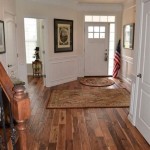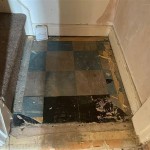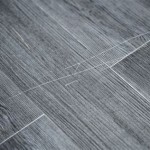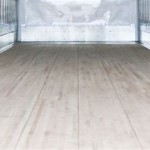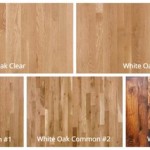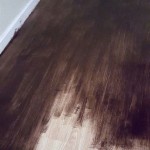Waterproof Wood Flooring: A Practical Choice for Bathrooms
The bathroom, a space inherently associated with moisture, presents a unique set of challenges when it comes to flooring. Traditional wood flooring, prized for its aesthetic appeal and warmth, is often considered unsuitable for bathrooms due to its susceptibility to water damage. However, advancements in technology have led to the development of waterproof wood flooring options, making it a viable and increasingly popular choice for bathroom renovations and new constructions. This article explores the characteristics of waterproof wood flooring, its benefits, considerations for installation, and maintenance aspects relevant to bathroom applications.
The primary concern with using wood flooring in bathrooms stems from the porous nature of natural wood. Water can penetrate the wood fibers, leading to swelling, warping, and eventually, rot. This process not only compromises the structural integrity of the flooring but also provides a breeding ground for mold and mildew, posing potential health risks. Traditional wood flooring also requires periodic refinishing to maintain its appearance and protective seal, an undertaking that can be both time-consuming and costly.
Waterproof wood flooring aims to address these issues by incorporating various design and material innovations. The term "waterproof" should not be confused with "water-resistant". Water-resistant flooring can withstand spills and splashes for a limited time, but prolonged exposure to moisture will eventually cause damage. Waterproof flooring, on the other hand, is engineered to completely prevent water from penetrating the core of the material, essentially eliminating the risks associated with water damage.
Several types of flooring are marketed as waterproof wood flooring, each with its own construction and performance characteristics. Understanding these differences is crucial to selecting the most appropriate option for a specific bathroom environment.
Understanding Waterproof Wood Flooring Options
While the term "waterproof wood flooring" suggests a direct application of traditional wood planks in a waterproof format, the reality is often more nuanced. The term typically encompasses several types of flooring that mimic the appearance of wood while offering superior water resistance and, in some cases, complete waterproof capabilities.
One common type is Luxury Vinyl Plank (LVP) or Luxury Vinyl Tile (LVT) flooring. These products utilize multiple layers, including a waterproof core typically made of PVC or a composite material, a printed layer that replicates the look of wood grain, and a protective wear layer that resists scratches and dents. The waterproof core prevents water from seeping through, while the wear layer ensures durability and longevity, even in high-traffic bathrooms.
Another option is Wood Plastic Composite (WPC) flooring. WPC flooring shares similarities with LVP/LVT but incorporates wood flour or other wood-like materials into the core. This addition can enhance the warmth and feel of the flooring compared to purely vinyl-based options. The core remains waterproof, preventing water damage, and the surface layers provide the desired wood appearance and protection.
A relatively newer category is Waterproof Engineered Hardwood. This type of flooring consists of a real wood veneer bonded to a waterproof core, often made of a mineral composite or a high-density polymer. The real wood veneer provides the authentic look and feel of hardwood, while the waterproof core ensures protection against moisture damage. This option offers a more premium aesthetic compared to vinyl or WPC flooring but typically comes at a higher price point.
Each of these options has its own advantages and disadvantages in terms of cost, appearance, durability, and ease of installation. Careful consideration of these factors is essential when selecting waterproof wood flooring for a bathroom.
The Benefits of Waterproof Wood Flooring in Bathrooms
The primary benefit of waterproof wood flooring in bathrooms is, of course, its resistance to water damage. This characteristic eliminates the risks associated with traditional wood flooring, such as swelling, warping, and mold growth. This is particularly important in bathrooms, where spills, splashes, and humidity are common occurrences.
Durability is another significant advantage. Waterproof wood flooring is designed to withstand the rigors of daily use, including high foot traffic, exposure to moisture, and potential impacts. The wear layer, typically found in LVP/LVT and WPC flooring, provides excellent resistance to scratches, dents, and stains, ensuring that the flooring maintains its appearance over time. Even waterproof engineered hardwood flooring offers enhanced durability compared to traditional hardwood due to the protective core.
Maintenance is simplified with waterproof wood flooring. Unlike traditional wood flooring, which requires periodic sanding, refinishing, and the application of protective sealants, waterproof wood flooring typically only requires regular sweeping, vacuuming, and occasional mopping with a mild detergent. The waterproof surface prevents liquids from penetrating the material, making it easy to clean spills and prevent stains. This low-maintenance aspect is particularly appealing for busy homeowners.
Aesthetic appeal is another key consideration. Waterproof wood flooring is available in a wide range of styles, colors, and textures, mimicking the look of various wood species, including oak, maple, walnut, and hickory. The realistic wood grain patterns and textures provide a warm and inviting atmosphere, enhancing the overall aesthetic of the bathroom. This versatility allows homeowners to achieve the desired look without sacrificing practicality and durability.
Furthermore, waterproof wood flooring often offers enhanced comfort underfoot compared to traditional tile or stone flooring. The resilient nature of LVP/LVT and WPC flooring provides a softer and warmer surface, making it more comfortable to walk on bare feet. This can be particularly beneficial in bathrooms, where users often spend time barefoot.
Installation and Maintenance Considerations
Proper installation is crucial to ensuring the waterproof performance of these flooring options. While some waterproof wood flooring products are designed for DIY installation, others may require professional installation to ensure a proper seal and prevent water from seeping underneath the flooring.
Subfloor preparation is essential. The subfloor must be clean, level, and dry before installing waterproof wood flooring. Any imperfections or moisture issues in the subfloor can compromise the performance and longevity of the flooring. In some cases, a moisture barrier may be required to further protect the flooring from moisture intrusion.
When installing click-lock LVP/LVT or WPC flooring, it is important to ensure that the planks or tiles are properly aligned and locked together to create a watertight seal. Gaps or misalignments can allow water to seep through, negating the waterproof benefits of the flooring. Following the manufacturer's instructions carefully is crucial.
For waterproof engineered hardwood flooring, professional installation is typically recommended to ensure proper adhesion and sealing. The installation process may involve the use of adhesives and sealants to create a waterproof barrier between the flooring and the subfloor. A skilled installer can ensure that these materials are applied correctly and that the flooring is properly sealed around edges and fixtures.
Maintenance is relatively straightforward. Regular sweeping or vacuuming is recommended to remove dirt and debris. Occasional mopping with a mild detergent is sufficient to clean the flooring and remove stains. Avoid using harsh chemicals or abrasive cleaners, as these can damage the surface of the flooring.
It is also important to address any spills or leaks promptly. While waterproof wood flooring is designed to prevent water damage, prolonged exposure to standing water can still cause issues. Wipe up spills immediately to prevent water from seeping into seams or around fixtures. Inspect the flooring regularly for any signs of damage or wear and address any issues promptly to prevent further problems.
The selection of appropriate sealants around toilets, bathtubs, and showers is vital. Using high-quality, waterproof caulk is essential to prevent water from seeping behind these fixtures and damaging the subfloor or surrounding walls. Regularly inspect the caulk for cracks or damage and reapply as needed.
Finally, consider using rugs or mats in high-traffic areas or near sinks and showers to protect the flooring from scratches and excessive moisture. These mats can help absorb spills and prevent dirt from being tracked onto the flooring, extending its lifespan and maintaining its appearance.
By understanding the characteristics of waterproof wood flooring, its benefits, installation requirements, and maintenance practices, homeowners can make informed decisions when selecting flooring for their bathrooms. The proper selection and installation, combined with diligent maintenance, can ensure that waterproof wood flooring provides a durable, aesthetically pleasing, and long-lasting solution for this challenging environment.

What Is The Best Way To Waterproof Wood Flooring Esb

Wood Floor Bathrooms How To Do Them Right Floorings

Waterproof Laminate Flooring Review Pros And Cons

Can I Put Hardwood Floors In My Bathroom Lifecore Flooring

Best Waterproof Flooring For Bathrooms Floorset

Wading Through Waterproof Flooring The Good Guys

Waterproof Bathroom Flooring Options Twenty Oak

The Best Waterproof Flooring Options Inc

Waterproof Wood Flooring Engineered Hardwood Raintree Floors

Decotalk L And Stick Floor Tile Wood Flooring Planks 6 X36 Vinyl Self Adhesive Brown Tiles Waterproof Laminate 3pcs Bathroom Look
Related Posts

